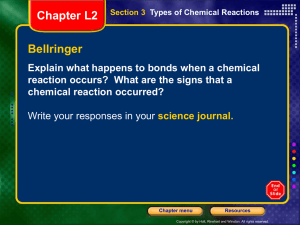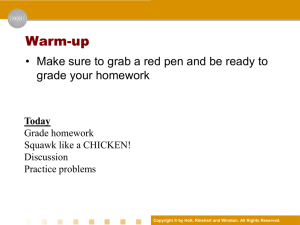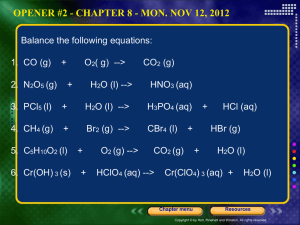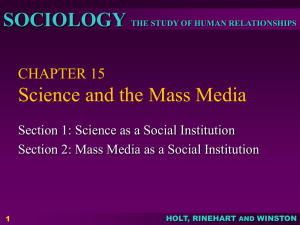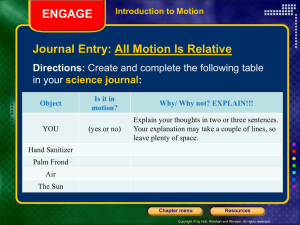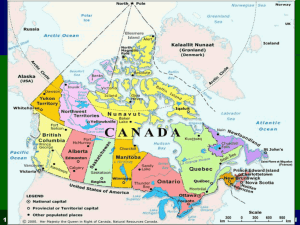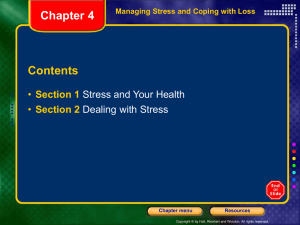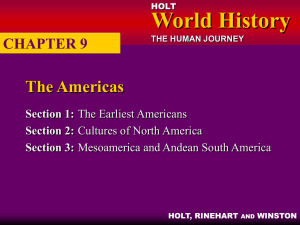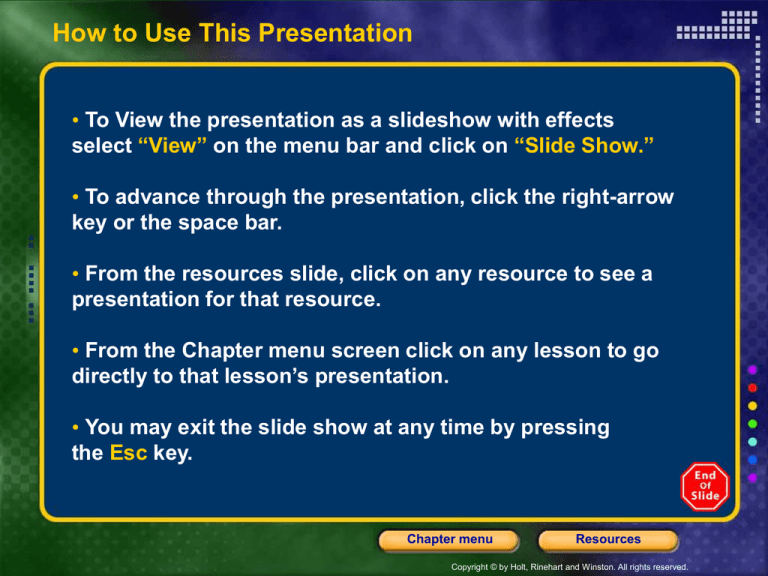
How to Use This Presentation
• To View the presentation as a slideshow with effects
select “View” on the menu bar and click on “Slide Show.”
• To advance through the presentation, click the right-arrow
key or the space bar.
• From the resources slide, click on any resource to see a
presentation for that resource.
• From the Chapter menu screen click on any lesson to go
directly to that lesson’s presentation.
• You may exit the slide show at any time by pressing
the Esc key.
Chapter menu
Resources
Copyright © by Holt, Rinehart and Winston. All rights reserved.
Resources
Bellringers
Chapter Presentation
Transparencies
Standardized Test Prep
Visual Concepts
Image and Math Focus Bank
Chapter menu
Resources
Copyright © by Holt, Rinehart and Winston. All rights reserved.
Chapter 5
Matter in Motion
Table of Contents
Section 1 Measuring Motion
Section 2 What Is a Force?
Section 3 Friction: A Force That Opposes Motion
Section 4 Gravity: A Force of Attraction
Chapter menu
Resources
Copyright © by Holt, Rinehart and Winston. All rights reserved.
Chapter 5
Section 1 Measuring Motion
Bellringer
Describe your position in the classroom using a
reference point and a set of reference directions.
Record your response in your science journal.
Chapter menu
Resources
Copyright © by Holt, Rinehart and Winston. All rights reserved.
Chapter 5
Section 1 Measuring Motion
Objectives
• Describe the motion of an object by the position of
the object in relation to a reference point.
• Identify the two factors that determine speed.
• Explain the difference between speed and velocity.
Chapter menu
Resources
Copyright © by Holt, Rinehart and Winston. All rights reserved.
Chapter 5
Section 1 Measuring Motion
Objectives, continued
• Analyze the relationship between velocity and
acceleration.
• Demonstrate that changes in motion can be
measured and represented on a graph.
Chapter menu
Resources
Copyright © by Holt, Rinehart and Winston. All rights reserved.
Chapter 5
Section 1 Measuring Motion
Observing Motion by Using a Reference Point
• Motion is an object’s change in position relative to
another object, or reference point. The object that
appears to stay in place is called a reference point.
• The direction of an object’s motion can be described
with a reference direction, such as north, south, east,
west, up, or down.
• Common Reference Points The Earth’s surface is a
common reference point for determining motion.
Chapter menu
Resources
Copyright © by Holt, Rinehart and Winston. All rights reserved.
Chapter 5
Section 1 Measuring Motion
Motion
Click below to watch the Visual Concept.
Visual Concept
You may stop the video at any time by pressing
the Esc key.
Chapter menu
Resources
Copyright © by Holt, Rinehart and Winston. All rights reserved.
Chapter 5
Section 1 Measuring Motion
Speed Depends on Distance and Time
• Speed is the distance traveled by an object divided
by the time taken to travel that distance.
• The SI unit for speed is meters per second (m/s).
Kilometers per hour (km/h), feet per second (ft/s), and
miles per hour (mi/h) are other units commonly used
to express speed.
Chapter menu
Resources
Copyright © by Holt, Rinehart and Winston. All rights reserved.
Chapter 5
Section 1 Measuring Motion
Speed Depends on Distance and Time, continued
• Determining Average Speed Average speed equals
the total distance divided by the total time.
average speed =
total distance
total time
• Recognizing Speed on a Graph Speed can be
shown on a graph of distance versus time, as shown
on the next slide.
Chapter menu
Resources
Copyright © by Holt, Rinehart and Winston. All rights reserved.
Chapter 5
Section 1 Measuring Motion
Chapter menu
Resources
Copyright © by Holt, Rinehart and Winston. All rights reserved.
Chapter 5
Section 1 Measuring Motion
Chapter menu
Resources
Copyright © by Holt, Rinehart and Winston. All rights reserved.
Chapter 5
Section 1 Measuring Motion
Velocity: Direction Matters
• The speed of an object in a particular direction is
called velocity.
• Speed and velocity are two different terms with two
different meanings. Velocity must include a reference
direction.
Chapter menu
Resources
Copyright © by Holt, Rinehart and Winston. All rights reserved.
Chapter 5
Section 1 Measuring Motion
Velocity: Direction Matters, continued
• Changing Velocity You can think of velocity as
the rate of change of an object’s position. An object’s
velocity is constant only if its speed and direction
don’t change.
• Combining Velocities You can combine different
velocities to find the resultant velocity. The next slide
shows how you can combine velocities to find the
resultant velocity.
Chapter menu
Resources
Copyright © by Holt, Rinehart and Winston. All rights reserved.
Chapter 5
Section 1 Measuring Motion
Chapter menu
Resources
Copyright © by Holt, Rinehart and Winston. All rights reserved.
Chapter 5
Section 1 Measuring Motion
Acceleration
• The rate at which velocity changes over time is called
acceleration. An object accelerates if its speed, or
direction, or both change.
• An increase in velocity is commonly called positive
acceleration. A decrease in velocity is commonly called
negative acceleration, or deceleration.
Chapter menu
Resources
Copyright © by Holt, Rinehart and Winston. All rights reserved.
Chapter 5
Section 1 Measuring Motion
Acceleration, continued
• Calculating Average Acceleration You can find
average acceleration by using the equation:
average acceleration =
final velocity starting velocity
time it takes to change velocity
• Velocity is expressed in meters per second (m/s),
and time is expressed in seconds (s). So acceleration
is expressed in meters per second per second, or
(m/s)/s, which equals m/s2.
Chapter menu
Resources
Copyright © by Holt, Rinehart and Winston. All rights reserved.
Chapter 5
Section 1 Measuring Motion
Chapter menu
Resources
Copyright © by Holt, Rinehart and Winston. All rights reserved.
Chapter 5
Section 1 Measuring Motion
Acceleration, continued
• Recognizing Acceleration on a Graph Acceleration
can be shown on a graph of velocity versus time.
Chapter menu
Resources
Copyright © by Holt, Rinehart and Winston. All rights reserved.
Chapter 5
Section 1 Measuring Motion
Acceleration, continued
• Circular Motion: Continuous Acceleration An
object traveling in a circular motion is always changing
its direction. Therefore, its velocity is always changing,
so it is accelerating.
• The acceleration that occurs in circular motion is
known as centripetal acceleration.
Chapter menu
Resources
Copyright © by Holt, Rinehart and Winston. All rights reserved.
Chapter 5
Section 2 What Is a Force?
Bellringer
Look around the room and think about the objects
you see in terms of force. A force is always exerted
by one object on another object. Then, answer the
following questions in your science journal:
Where do you see a force happening in the room
right now? Which object is exerting the force, and
which is receiving it?
Chapter menu
Resources
Copyright © by Holt, Rinehart and Winston. All rights reserved.
Chapter 5
Section 2 What Is a Force?
Objectives
• Describe forces, and explain how forces act on objects.
• Determine the net force when more than one force is
acting on an object.
• Compare balanced and unbalanced forces.
• Describe ways that unbalanced forces cause changes
in motion.
Chapter menu
Resources
Copyright © by Holt, Rinehart and Winston. All rights reserved.
Chapter 5
Section 2 What Is a Force?
Forces Acting on Objects
• In science, a force is simply a push or a pull exerted
on an object in order to change the motion of the
object. All forces have both size and direction.
• A force can change the acceleration of an object.
This acceleration can be a change in the speed or
direction of the object.
• Scientists express force using a unit called the
newton (N).
Chapter menu
Resources
Copyright © by Holt, Rinehart and Winston. All rights reserved.
Chapter 5
Section 2 What Is a Force?
Forces Acting on Objects, continued
• Unseen Sources and Receivers of Forces It is not
always easy to tell what is exerting a force or what is
receiving a force. For example, you cannot see what
exerts the force that pulls magnets to refrigerators.
• You cannot see that the air around you is held near
Earth’s surface by a force called gravity.
Chapter menu
Resources
Copyright © by Holt, Rinehart and Winston. All rights reserved.
Chapter 5
Section 2 What Is a Force?
Determining Net Force
• Usually, more than one force is acting on an object.
The net force is the combination all of the forces
acting on an object.
• Determining net force depends on the directions of
the forces.
Chapter menu
Resources
Copyright © by Holt, Rinehart and Winston. All rights reserved.
Chapter 5
Section 2 What Is a Force?
Determining Net Force, continued
• Forces in the Same Direction Two forces are
added to determine the net force if the forces act in
the same direction. The net force will be in the same
direction as the individual forces.
• Forces in Different Directions If forces are acting
in opposite directions, the net force can be found by
subtracting the smaller force from the larger one.
Chapter menu
Resources
Copyright © by Holt, Rinehart and Winston. All rights reserved.
Chapter 5
Section 2 What Is a Force?
Chapter menu
Resources
Copyright © by Holt, Rinehart and Winston. All rights reserved.
Chapter 5
Section 2 What Is a Force?
Balanced and Unbalanced Forces
• Balanced Forces When the forces on an object
produce a net force of 0 N, the forces are balanced.
• Balanced forces will not cause a change in the motion
of a moving object. Balanced forces do not cause a
nonmoving object to start moving.
Chapter menu
Resources
Copyright © by Holt, Rinehart and Winston. All rights reserved.
Chapter 5
Section 2 What Is a Force?
Balanced and Unbalanced Forces, continued
• Unbalanced Forces When the net force on an
object is not 0 N, the forces on the object are
unbalanced.
• Unbalanced forces produce a change in motion,
such as a change in speed or a change in direction.
Unbalanced forces are necessary to cause a nonmoving object to start moving, or to change the
motion of moving objects.
Chapter menu
Resources
Copyright © by Holt, Rinehart and Winston. All rights reserved.
Chapter 5
Section 3 Friction: A Force That Opposes Motion
Bellringer
Suppose you and a younger sister or brother are at a
neighborhood pool. Your sister or brother asks why
there are signs that say “NO RUNNING.” What would
be your answer?
Record your response in your science journal.
Chapter menu
Resources
Copyright © by Holt, Rinehart and Winston. All rights reserved.
Chapter 5
Section 3 Friction: A Force That Opposes Motion
Objectives
• Explain why friction occurs.
• List the two types of friction,and give examples of
each type.
• Explain how friction can be both harmful and helpful.
Chapter menu
Resources
Copyright © by Holt, Rinehart and Winston. All rights reserved.
Chapter 5
Section 3 Friction: A Force That Opposes Motion
The Source of Friction
• Friction is a force that opposes motion between two
surfaces that are in contact.
• Friction occurs because the surface of any object is
rough. Even surfaces that feel smooth are covered
with microscopic hills and valleys.
Chapter menu
Resources
Copyright © by Holt, Rinehart and Winston. All rights reserved.
Chapter 5
Section 3 Friction: A Force That Opposes Motion
The Source of Friction, continued
• When two surfaces are in contact, the microscopic
hills and valleys of one surface stick to the tiny hills
and valleys of the other surface. This contact causes
friction.
Chapter menu
Resources
Copyright © by Holt, Rinehart and Winston. All rights reserved.
Chapter 5
Section 3 Friction: A Force That Opposes Motion
The Source of Friction, continued
• The Effect of Force on Friction The amount of
friction depends on the force pushing the surfaces
together. If this force increases, the hills and valleys
of the surfaces can come into closer contact.
• The close contact increases the friction between the
surfaces. Objects that weigh less exert less downward
force than objects that weigh more, as shown on the
next slide.
Chapter menu
Resources
Copyright © by Holt, Rinehart and Winston. All rights reserved.
Chapter 5
Section 3 Friction: A Force That Opposes Motion
Chapter menu
Resources
Copyright © by Holt, Rinehart and Winston. All rights reserved.
Chapter 5
Section 3 Friction: A Force That Opposes Motion
The Source of Friction, continued
• The Effect of Rougher Surfaces on Friction
Rough surfaces have more microscopic hills and
valleys than smooth surfaces do.
• So, the rougher the surface is, the greater the
friction is.
Chapter menu
Resources
Copyright © by Holt, Rinehart and Winston. All rights reserved.
Chapter 5
Section 3 Friction: A Force That Opposes Motion
Types of Friction
• Kinetic Friction The word kinetic means “moving.”
So, kinetic friction is friction between moving surfaces.
• The amount of kinetic friction between two surfaces
depends in part on how the surfaces move. Surfaces
can slide past each other, or a surface can roll over
another surface.
Chapter menu
Resources
Copyright © by Holt, Rinehart and Winston. All rights reserved.
Chapter 5
Section 3 Friction: A Force That Opposes Motion
Types of Friction, continued
• Usually, the force of sliding kinetic friction is greater
than the force of rolling kinetic friction. It is usually
easier to move objects on wheels than to slide the
objects along the floor, as shown below.
Chapter menu
Resources
Copyright © by Holt, Rinehart and Winston. All rights reserved.
Chapter 5
Section 3 Friction: A Force That Opposes Motion
Types of Friction, continued
• Static Friction When a force is applied to an object
but does not cause the object to move, static friction
occurs.
• The word static means “not moving.” The object does
not move because the force of static friction balances
the force applied.
• Static friction disappears as soon as an object starts
moving, and then kinetic friction immediately occurs.
Chapter menu
Resources
Copyright © by Holt, Rinehart and Winston. All rights reserved.
Chapter 5
Section 3 Friction: A Force That Opposes Motion
Chapter menu
Resources
Copyright © by Holt, Rinehart and Winston. All rights reserved.
Chapter 5
Section 3 Friction: A Force That Opposes Motion
Friction: Harmful and Helpful
• Without friction, a car’s tires could not push against
the ground to move the car forward, and the brakes
could not stop the car. Without friction, a car is useless.
• However, friction can also cause problems in a car.
Friction between moving engine parts increases their
temperature and causes the parts to wear down.
• Friction can be both harmful and helpful, so it may be
necessary to decrease or increase friction.
Chapter menu
Resources
Copyright © by Holt, Rinehart and Winston. All rights reserved.
Chapter 5
Section 3 Friction: A Force That Opposes Motion
Friction: Harmful and Helpful, continued
• Some Ways to Reduce Friction One way to reduce
friction is to use lubricants. Lubricants are substances
that are applied to surfaces to reduce the friction
between the surfaces.
• Some examples of common lubricants are motor oil,
wax, and grease. Lubricants are usually liquids, but
they can be solids or gases.
Chapter menu
Resources
Copyright © by Holt, Rinehart and Winston. All rights reserved.
Chapter 5
Section 3 Friction: A Force That Opposes Motion
Friction: Harmful and Helpful, continued
• Friction can be reduced by switching from sliding
kinetic friction to rolling kinetic friction. Ball bearings
can be placed between wheels and axels to make it
easier for wheels to turn by reducing friction.
• Another way to reduce friction is to make surfaces
that rub against each other smoother.
Chapter menu
Resources
Copyright © by Holt, Rinehart and Winston. All rights reserved.
Chapter 5
Section 3 Friction: A Force That Opposes Motion
Friction: Harmful and Helpful, continued
• Some Ways to Increase Friction Making surfaces
rougher is one way to increase friction. For example,
sand scattered on icy roads keeps cars from skidding.
• Another way to increase friction is to increase the
force pushing the surfaces together. For example, if you
are sanding a piece of wood, you can sand the wood
faster by pressing harder on the sandpaper.
Chapter menu
Resources
Copyright © by Holt, Rinehart and Winston. All rights reserved.
Chapter 5
Section 4 Gravity: A Force of Attraction
Bellringer
Significantly decreased gravity gives astronauts the
sensation of being weightless and forces astronauts
to make many adjustments in their activities. Write a
paragraph explaining what you would like and dislike
about living with reduced gravity.
Write your paragraph in your science journal.
Chapter menu
Resources
Copyright © by Holt, Rinehart and Winston. All rights reserved.
Chapter 5
Section 4 Gravity: A Force of Attraction
Objectives
• Describe gravity and its effect on matter.
• Explain the law of universal gravitation.
• Describe the difference between mass and weight.
Chapter menu
Resources
Copyright © by Holt, Rinehart and Winston. All rights reserved.
Chapter 5
Section 4 Gravity: A Force of Attraction
The Effects of Gravity on Matter
• Gravity is a force of attraction between objects that is
due to their masses. Gravity can change the motion of an
object by changing its speed, direction, or both.
• All matter has mass, and gravity is a result of mass.
Therefore, all matter is affected by gravity and all objects
experience an attraction toward all other objects.
• The mass of most objects is too small to cause a force
large enough to move objects toward each other.
Chapter menu
Resources
Copyright © by Holt, Rinehart and Winston. All rights reserved.
Chapter 5
Section 4 Gravity: A Force of Attraction
The Effects of Gravity on Matter, continued
• The Size of Earth’s Gravitational Force Compared
with all objects around you, Earth has a huge mass.
Therefore, Earth’s gravitational force is very large.
• You must apply forces to overcome the Earth’s
gravitational force any time you lift objects or even
parts of your body.
Chapter menu
Resources
Copyright © by Holt, Rinehart and Winston. All rights reserved.
Chapter 5
Section 4 Gravity: A Force of Attraction
Newton and the Study of Gravity
• The Core of an Idea Why do objects fall toward the
Earth? What keeps the planets moving in the sky?
• In 1665, British scientist
Sir Isaac Newton made the
connection between these
two questions when, as
legend has it, he saw an
apple falling from a tree.
Chapter menu
Resources
Copyright © by Holt, Rinehart and Winston. All rights reserved.
Chapter 5
Section 4 Gravity: A Force of Attraction
Newton and the Study of Gravity, continued
• Newton knew that unbalanced forces are needed to
change the motion of objects. He concluded that an
unbalanced force on the apple made the apple fall.
• He also reasoned that an unbalanced force on the
moon kept the moon moving around the Earth.
• He proposed that these two forces are actually the
same force––gravity.
Chapter menu
Resources
Copyright © by Holt, Rinehart and Winston. All rights reserved.
Chapter 5
Section 4 Gravity: A Force of Attraction
Newton and the Study of Gravity, continued
• The Birth of a Law Newton summarized his ideas
about gravity in a law known as the law of universal
gravitation. This law describes the relationships
between gravitational force, mass, and distance.
• The law is called universal because it applies to all
objects in the universe.
Chapter menu
Resources
Copyright © by Holt, Rinehart and Winston. All rights reserved.
Chapter 5
Section 4 Gravity: A Force of Attraction
The Law of Universal Gravitation
• Part 1: Gravitational Force Increases as Mass
Increases Gravitational force is small between objects
that have small masses. Gravitational force is large when
the mass of one or both objects is large.
• Part 2: Gravitational Force Decreases as Distance
Increases Gravitational force is strong when distance
between two objects is small. If the distance between two
objects increases, the gravitational force pulling them
together decreases rapidly.
Chapter menu
Resources
Copyright © by Holt, Rinehart and Winston. All rights reserved.
Chapter 5
Section 4 Gravity: A Force of Attraction
Chapter menu
Resources
Copyright © by Holt, Rinehart and Winston. All rights reserved.
Chapter 5
Section 4 Gravity: A Force of Attraction
Weight as a Measure of Gravitational Force
• The Differences Between Weight and Mass Weight
is related to mass, but they are not the same.
• Weight is a measure of the gravitational force on an
object. Weight changes whenever gravitational force
changes.
• Mass is the amount of matter in an object. An object’s
mass does not change if gravitational force changes.
Chapter menu
Resources
Copyright © by Holt, Rinehart and Winston. All rights reserved.
Chapter 5
Section 4 Gravity: A Force of Attraction
Chapter menu
Resources
Copyright © by Holt, Rinehart and Winston. All rights reserved.
Chapter 5
Section 4 Gravity: A Force of Attraction
Weight as a Measure of Gravity, continued
• Units of Weight and Mass The SI unit of force is a
newton (N). Gravity is a force, and weight is a measure
of gravity. So, weight is also measured in newtons.
• The SI unit of mass is the kilogram (kg). Mass is often
measured in grams (g) and milligrams (mg) as well.
• On Earth, a 100 g object weighs about 1 N.
Chapter menu
Resources
Copyright © by Holt, Rinehart and Winston. All rights reserved.
Chapter 5
Matter in Motion
Concept Map
Use the terms below to complete the concept map
on the next slide.
speed
time
velocity
motion
acceleration
Chapter menu
Resources
Copyright © by Holt, Rinehart and Winston. All rights reserved.
Chapter 5
Matter in Motion
Chapter menu
Resources
Copyright © by Holt, Rinehart and Winston. All rights reserved.
Chapter 5
Matter in Motion
Chapter menu
Resources
Copyright © by Holt, Rinehart and Winston. All rights reserved.
End of Chapter 5 Show
Chapter menu
Resources
Copyright © by Holt, Rinehart and Winston. All rights reserved.
Chapter 5
Standardized Test Preparation
Reading
Read each of the passages. Then answer the
questions that follow each passage.
Chapter menu
Resources
Copyright © by Holt, Rinehart and Winston. All rights reserved.
Chapter 5
Standardized Test Preparation
Passage 1 If you look closely at the surface of a golf
ball, you’ll see dozens of tiny dimples. When air flows
past these dimples, the air is stirred up and stays near
the surface of the ball. By keeping air moving near the
surface of the ball, the dimples help the golf ball move
faster and farther through the air.
Continued on the next slide
Chapter menu
Resources
Copyright © by Holt, Rinehart and Winston. All rights reserved.
Chapter 5
Standardized Test Preparation
Passage 1, continued Jeff DiTullio, a teacher at MIT
in Cambridge, Massachusetts, decided to apply this
principle to a baseball bat. When DiTullio tested his
dimpled bat in a wind tunnel, he found that the bat
could be swung 3% to 5% faster than a bat without
dimples. That increase may not seem like much, but
the dimpled bat could add about 5 m of distance to a
fly ball!
Chapter menu
Resources
Copyright © by Holt, Rinehart and Winston. All rights reserved.
Chapter 5
Standardized Test Preparation
1. Who is Jeff DiTullio?
A the inventor of the dimpled golf ball
B a teacher at Cambridge University
C the inventor of the dimpled bat
D a professional baseball player
Chapter menu
Resources
Copyright © by Holt, Rinehart and Winston. All rights reserved.
Chapter 5
Standardized Test Preparation
1. Who is Jeff DiTullio?
A the inventor of the dimpled golf ball
B a teacher at Cambridge University
C the inventor of the dimpled bat
D a professional baseball player
Chapter menu
Resources
Copyright © by Holt, Rinehart and Winston. All rights reserved.
Chapter 5
Standardized Test Preparation
2. Which of the following ideas is NOT stated in the
passage?
F Dimples make DiTullio’s bat move faster.
G MIT is in Cambridge, Massachusetts.
H Air that is stirred up near the surface of DiTullio’s
bat makes it easier to swing the bat faster.
I DiTullio will make a lot of money from his invention.
Chapter menu
Resources
Copyright © by Holt, Rinehart and Winston. All rights reserved.
Chapter 5
Standardized Test Preparation
2. Which of the following ideas is NOT stated in the
passage?
F Dimples make DiTullio’s bat move faster.
G MIT is in Cambridge, Massachusetts.
H Air that is stirred up near the surface of DiTullio’s
bat makes it easier to swing the bat faster.
I DiTullio will make a lot of money from his invention.
Chapter menu
Resources
Copyright © by Holt, Rinehart and Winston. All rights reserved.
Chapter 5
Standardized Test Preparation
3. In the passage, what does wind tunnel mean?
A a place to practice batting
B a place to test the speed of objects in the air
C a baseball stadium
D a passageway that is shielded from the wind
Chapter menu
Resources
Copyright © by Holt, Rinehart and Winston. All rights reserved.
Chapter 5
Standardized Test Preparation
3. In the passage, what does wind tunnel mean?
A a place to practice batting
B a place to test the speed of objects in the air
C a baseball stadium
D a passageway that is shielded from the wind
Chapter menu
Resources
Copyright © by Holt, Rinehart and Winston. All rights reserved.
Chapter 5
Standardized Test Preparation
Passage 2 The Golden Gate Bridge in San Francisco,
California, is one of the most famous landmarks in the
world. Approximately 9 million people from around the
world visit the bridge each year.
The Golden Gate Bridge is a suspension bridge.
A suspension bridge is one in which the roadway is
hung, or suspended, from huge cables that extend from
one end of the bridge to the other.
Continued on the next slide
Chapter menu
Resources
Copyright © by Holt, Rinehart and Winston. All rights reserved.
Chapter 5
Standardized Test Preparation
Passage 2, continued The main cables on the
Golden Gate Bridge are 2.33 km long. Many forces
act on the main cables. For example, smaller cables
pull down on the main cables to connect the roadway
to the main cables. And two towers that are 227 m tall
push up on the main cables. The forces on the main
cable must be balanced, or the bridge will collapse.
Chapter menu
Resources
Copyright © by Holt, Rinehart and Winston. All rights reserved.
Chapter 5
Standardized Test Preparation
1. In this passage, what does landmarks mean?
A large areas of land
B well-known places
C street signs
D places where people meet
Chapter menu
Resources
Copyright © by Holt, Rinehart and Winston. All rights reserved.
Chapter 5
Standardized Test Preparation
1. In this passage, what does landmarks mean?
A large areas of land
B well-known places
C street signs
D places where people meet
Chapter menu
Resources
Copyright © by Holt, Rinehart and Winston. All rights reserved.
Chapter 5
Standardized Test Preparation
2. Which of the following statements is a fact
from the passage?
F The roadway of the Golden Gate Bridge is
suspended from huge cables.
G The towers of the Golden Gate Bridge are
2.33 km tall.
H The main cables connect the roadway to the
towers.
I The forces on the cables are not balanced.
Chapter menu
Resources
Copyright © by Holt, Rinehart and Winston. All rights reserved.
Chapter 5
Standardized Test Preparation
2. Which of the following statements is a fact
from the passage?
F The roadway of the Golden Gate Bridge is
suspended from huge cables.
G The towers of the Golden Gate Bridge are
2.33 km tall.
H The main cables connect the roadway to the
towers.
I The forces on the cables are not balanced.
Chapter menu
Resources
Copyright © by Holt, Rinehart and Winston. All rights reserved.
Chapter 5
Standardized Test Preparation
3. According to the passage, why do people from
around the world visit the Golden Gate Bridge?
A It is the longest bridge in the world.
B It is a suspension bridge.
C It is the only bridge that is painted orange.
D It is a famous landmark.
Chapter menu
Resources
Copyright © by Holt, Rinehart and Winston. All rights reserved.
Chapter 5
Standardized Test Preparation
3. According to the passage, why do people from
around the world visit the Golden Gate Bridge?
A It is the longest bridge in the world.
B It is a suspension bridge.
C It is the only bridge that is painted orange.
D It is a famous landmark.
Chapter menu
Resources
Copyright © by Holt, Rinehart and Winston. All rights reserved.
Chapter 5
Standardized Test Preparation
Interpreting Graphics
The graph below shows the data collected by a student
as she watched a squirrel running on the ground. Use
the graph below to answer the questions that follow.
Chapter menu
Resources
Copyright © by Holt, Rinehart and Winston. All rights reserved.
Chapter 5
Standardized Test Preparation
1. Which of the following best describes the motion
of the squirrel between 5 s and 8 s?
A The squirrel’s speed
increased.
B The squirrel’s speed
decreased.
C The squirrel’s speed
did not change.
D The squirrel moved
backward.
Chapter menu
Resources
Copyright © by Holt, Rinehart and Winston. All rights reserved.
Chapter 5
Standardized Test Preparation
1. Which of the following best describes the motion
of the squirrel between 5 s and 8 s?
A The squirrel’s speed
increased.
B The squirrel’s speed
decreased.
C The squirrel’s speed
did not change.
D The squirrel moved
backward.
Chapter menu
Resources
Copyright © by Holt, Rinehart and Winston. All rights reserved.
Chapter 5
Standardized Test Preparation
2. Which of the following statements about the motion
of the squirrel is true?
F The squirrel moved with the
greatest speed between 0 s and 5 s.
G The squirrel moved with the
greatest speed between 8 s and 10 s.
H The squirrel moved with a constant
speed between 0 s and 8 s.
I The squirrel moved with a constant
speed between 5 s and 10 s.
Chapter menu
Resources
Copyright © by Holt, Rinehart and Winston. All rights reserved.
Chapter 5
Standardized Test Preparation
2. Which of the following statements about the motion
of the squirrel is true?
F The squirrel moved with the
greatest speed between 0 s and 5 s.
G The squirrel moved with the
greatest speed between 8 s and 10 s.
H The squirrel moved with a constant
speed between 0 s and 8 s.
I The squirrel moved with a constant
speed between 5 s and 10 s.
Chapter menu
Resources
Copyright © by Holt, Rinehart and Winston. All rights reserved.
Chapter 5
Standardized Test Preparation
3. What is the average speed of the squirrel between
8 s and 10 s?
A 0.4 m/s
B 1 m/s
C 2 m/s
D 4 m/s
Chapter menu
Resources
Copyright © by Holt, Rinehart and Winston. All rights reserved.
Chapter 5
Standardized Test Preparation
3. What is the average speed of the squirrel between
8 s and 10 s?
A 0.4 m/s
B 1 m/s
C 2 m/s
D 4 m/s
Chapter menu
Resources
Copyright © by Holt, Rinehart and Winston. All rights reserved.
Chapter 5
Standardized Test Preparation
Math
Read each question and choose the best answer.
Chapter menu
Resources
Copyright © by Holt, Rinehart and Winston. All rights reserved.
Chapter 5
Standardized Test Preparation
1. The distance between Cedar Rapids, Iowa, and
Sioux Falls, South Dakota, is about 660 km. How long
will it take a car traveling with an average speed of 95
km/h to drive from Cedar Rapids to Sioux Falls?
A less than 1 h
B about 3 h
C about 7 h
D about 10 h
Chapter menu
Resources
Copyright © by Holt, Rinehart and Winston. All rights reserved.
Chapter 5
Standardized Test Preparation
1. The distance between Cedar Rapids, Iowa, and
Sioux Falls, South Dakota, is about 660 km. How long
will it take a car traveling with an average speed of 95
km/h to drive from Cedar Rapids to Sioux Falls?
A less than 1 h
B about 3 h
C about 7 h
D about 10 h
Chapter menu
Resources
Copyright © by Holt, Rinehart and Winston. All rights reserved.
Chapter 5
Standardized Test Preparation
2. Martha counted the number of people in each group
that walked into her school’s cafeteria. In the first 10
groups, she counted the following numbers of people:
6, 4, 9, 6, 4, 10, 9, 5, 9, and 8. What is the mode of this
set of data?
F 6
G 7
H 9
I 10
Chapter menu
Resources
Copyright © by Holt, Rinehart and Winston. All rights reserved.
Chapter 5
Standardized Test Preparation
2. Martha counted the number of people in each group
that walked into her school’s cafeteria. In the first 10
groups, she counted the following numbers of people:
6, 4, 9, 6, 4, 10, 9, 5, 9, and 8. What is the mode of this
set of data?
F 6
G 7
H 9
I 10
Chapter menu
Resources
Copyright © by Holt, Rinehart and Winston. All rights reserved.
Chapter 5
Standardized Test Preparation
3. Which of the following terms describes the angle
marked in the triangle below.
A acute
B obtuse
42°
C right
D None of the above
Chapter menu
Resources
Copyright © by Holt, Rinehart and Winston. All rights reserved.
Chapter 5
Standardized Test Preparation
3. Which of the following terms describes the angle
marked in the triangle below.
A acute
B obtuse
42°
C right
D None of the above
Chapter menu
Resources
Copyright © by Holt, Rinehart and Winston. All rights reserved.
Chapter 5
Standardized Test Preparation
4. Donnell collected money for a charity fundraiser.
After one hour, he counted the money and found that
he had raised $10.00 in bills and $3.74 in coins. Which
of the following represents the number of coins he
collected?
F 4 pennies, 9 nickels, 18 dimes, and 6 quarters
G 9 pennies, 7 nickels, 18 dimes, and 6 quarters
H 6 pennies, 7 nickels, 15 dimes, and 8 quarters
I 9 pennies, 8 nickels, 12 dimes, and 3 quarters
Chapter menu
Resources
Copyright © by Holt, Rinehart and Winston. All rights reserved.
Chapter 5
Standardized Test Preparation
4. Donnell collected money for a charity fundraiser.
After one hour, he counted the money and found that
he had raised $10.00 in bills and $3.74 in coins. Which
of the following represents the number of coins he
collected?
F 4 pennies, 9 nickels, 18 dimes, and 6 quarters
G 9 pennies, 7 nickels, 18 dimes, and 6 quarters
H 6 pennies, 7 nickels, 15 dimes, and 8 quarters
I 9 pennies, 8 nickels, 12 dimes, and 3 quarters
Chapter menu
Resources
Copyright © by Holt, Rinehart and Winston. All rights reserved.
Chapter 5
Section 1 Measuring Motion
Chapter menu
Resources
Copyright © by Holt, Rinehart and Winston. All rights reserved.
Chapter 5
Section 1 Measuring Motion
Chapter menu
Resources
Copyright © by Holt, Rinehart and Winston. All rights reserved.
Chapter 5
Section 1 Measuring Motion
Chapter menu
Resources
Copyright © by Holt, Rinehart and Winston. All rights reserved.
Chapter 5
Section 1 Measuring Motion
Chapter menu
Resources
Copyright © by Holt, Rinehart and Winston. All rights reserved.
Chapter 5
Section 2 What Is a Force?
Chapter menu
Resources
Copyright © by Holt, Rinehart and Winston. All rights reserved.
Chapter 5
Section 3 Friction: A Force That Opposes Motion
Chapter menu
Resources
Copyright © by Holt, Rinehart and Winston. All rights reserved.
Chapter 5
Section 3 Friction: A Force That Opposes Motion
Chapter menu
Resources
Copyright © by Holt, Rinehart and Winston. All rights reserved.
Chapter 5
Section 3 Friction: A Force That Opposes Motion
Chapter menu
Resources
Copyright © by Holt, Rinehart and Winston. All rights reserved.
Chapter 5
Section 3 Friction: A Force That Opposes Motion
Chapter menu
Resources
Copyright © by Holt, Rinehart and Winston. All rights reserved.
Chapter 5
Section 4 Gravity: A Force of Attraction
Chapter menu
Resources
Copyright © by Holt, Rinehart and Winston. All rights reserved.
Chapter 5
Section 4 Gravity: A Force of Attraction
Chapter menu
Resources
Copyright © by Holt, Rinehart and Winston. All rights reserved.
Chapter 5
Section 4 Gravity: A Force of Attraction
Chapter menu
Resources
Copyright © by Holt, Rinehart and Winston. All rights reserved.
Chapter 5
Standardized Test Preparation
Chapter menu
Resources
Copyright © by Holt, Rinehart and Winston. All rights reserved.
Chapter 5
Section 1 Measuring Motion
Chapter menu
Resources
Copyright © by Holt, Rinehart and Winston. All rights reserved.

